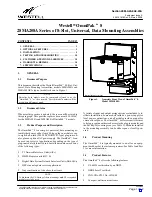
Section 28M-A20-8A0-20A
030-101678 Rev. A
R
0803IARA
6
j
Utility knife
j
Awl or drill with assorted bits
j
Hammer
j
Pliers or line cutters
j
Wirewrap tool
- UL LISTED HARDWARE NOTE -
To maintain the UL Listing of these mountings,
only
UL (or NRTL)
listed hardware should be used in this installation.
3.3
Determining the Mounting Location & Type
The OmniPak
t
8 should be installed by authorized trained
personnel only. In accordance with UL 60950, this equipment
is suitable for mounting on concrete or other noncombustible
surfaces only and in restricted access locations only. It is also
recommended that adequate horizontal and vertical space be
left between multiple installations to allow for proper cable ac-
cess and ventilation. The distance from the cable entry point
should be consistent with local installation practices.
3.3.1
Wall-Mounting Single Assemblies (Typical)
Mount the OmniPak
t
8 per local company practice, or if none
exist, per the instructions below. The OmniPak
t
8 is typically
wall-mounted at the customer premises. Westell recommends
mounting this OmniPak
t
8 to a backboard, concrete surface,
or other noncombustible surface. The OmniPak
t
8 has a back-
plate with built-in mounting brackets that contain predrilled
mounting holes (key-slotted holes).
1.
Expose the mounting holes on the OmniPak
t
8.
Unlock
and open the assembly module door, then remove the Facil-
ity Compartment cover by loosening the thumb-type screw.
2.
Select mounting location.
Select a location on a wall which
insures maximum and adequate air flow, heat dissipation,
and compliance with NEBS fire safety requirements, unless
otherwise dictated by local codes.
3.
Use template to mark mounted location on wall.
Find then
place the mounting template (last page of this document)
against the wall in the desired mounting location. With a
marking utensil, mark the location of the top-center self-
centering" hole on the wall, then set aside template.
(If the
self-centering feature is not desired, simply mark the locations of the
four corner mounting holes through the template, then go to Step 7.)
4.
Drill hole for self-centering hole.
Drill a hole in the wall for
the single, self-centering keyhole at the marked location.
5.
Install self-centering screw & hang assembly on screw.
Par-
tially install a screw into the hole drilled in the previous step,
leaving
approximately
¼-inch of the screw protruding from
the wall, then temporarily hang the OmniPak
t
8 from the
screw. Be sure the screw is firmly planted in the wall.
6.
Level the OmniPak
t
8 & mark the other mounting hole
locations on wall.
While being ready to catch the OmniPak-
t
8 should the single screw not stay in the wall, carefully let
the OmniPak
t
8 hang freely from the single screw on the
wall, to self-level" the assembly, then mark the locations of
the remaining four mounting holes. Set aside the assembly.
7.
Drill holes.
Drill appropriately-sized pilot holes, to accom-
modate the mounting screws or fasteners being used
(hardware not included), at the marked locations. Do not
make holes too big; the screws should be snug.
8.
Install screws or wall fasteners.
Partially install all screws
(or wall fasteners), leaving
approximately
¼-inch of the
screw protruding from the wall.
9.
Hang assembly on screws.
Lift the OmniPak
t
8 again,
align the mounting holes on the OmniPak
t
8 backplate (or
side wall) with the partially-installed screws, and hang the
OmniPak
t
8 on the protruding screws.
10.
Set screws.
Finish driving (tighten) all screws in place.
11.
Continue with wiring connections.
To access the plug-in
module slots or wiring connectors, remove the covers.
3.4
Installer Connections
After mounting the OmniPak
t
8, installer connections may be
performed. See Figure 4 and Figure 5 for wiring details.
Figure 2 is a front view showing the connector locations and
types. For equipment and personal safety, always perform
grounding connections first.
- CAUTION -
Improper grounding could be service affecting and cause service
interruptions.
- GROUNDING CAUTION -
Always follow local safety precautions and standard operating
procedures for grounding the equipment when installing, up-
grading, repairing or maintaining equipment. Any instructions
or information contained herein is subordinate to local codes, op-
erating procedures or practices.
3.4.1
Chassis/Frame Ground Connections
To ensure safety to personnel, Westell recommends grounding
the OmniPak
t
8 as shown in Figure 4a, unless otherwise dic-
tated by local codes. For applications requiring chassis ground
to be connected to circuit ground, as shown in Figure 4b, an op-
tional green wire strap is provided for installation between the
GND lug and the TB1 GND terminal.
- GROUNDING NOTES -
Always follow local safety precautions and standard operating proce-
dures for grounding the equipment when installing, upgrading, or
maintaining equipment. Any instructions or information contained
herein is subordinate to local codes and operating procedures or prac-
tices.
To maintain the UL Listing of these mountings, observe the following
when performing all grounding/bonding connections:
j
Only use conductors containing a like or similar metal type:
do not intermix metals.
j
Any unplated conductor (attached to ground lug) shall be
brought to a bright finish and then coated with an anti-oxi-
dant prior to connection.
j
All grounding/bonding hardware must be listed by an NRTL.
j
#6 AWG copper wire should be used.
3.4.2
Power Connections
Modules installed in the OmniPak
t
8 can be either span (line)
or locally powered. Local power may be internal with a plug-in












